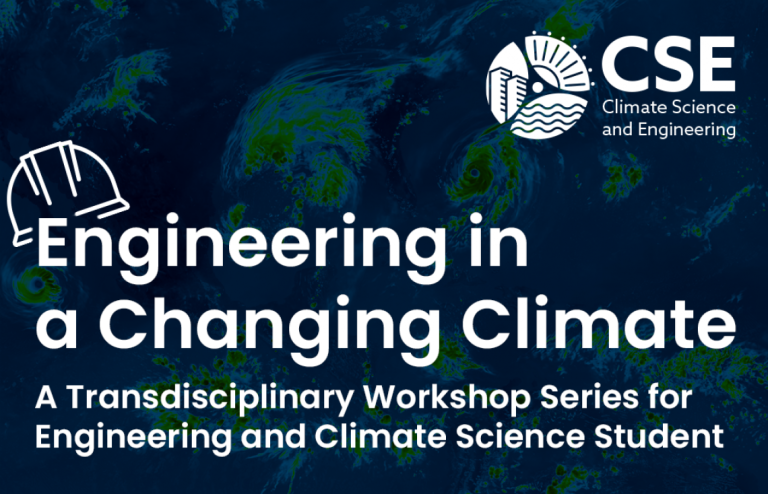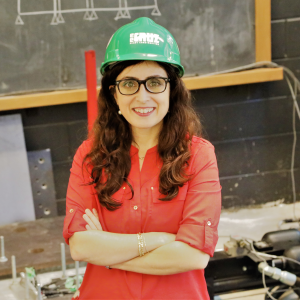This module will introduce you to key concepts of climate science and climate modeling that are relevant to engineering and infrastructure design.
Engineering in a Changing Climate
Project Description
Climate change poses an imminent threat to humanity through its increased stress on infrastructure (among other stresses), leading to increasingly deadly natural disasters, food shortages, and the failure of our built environment. Despite the clear need for collaboration between climate scientists and civil engineers to address and adapt to this threat, there are limited post-secondary educational and training resources available to students at the climate science-engineering interface. To address this gap, the University of Toronto Centre for Climate Science and Engineering in collaboration with the University of Western Ontario has developed a short-duration learning opportunity targeted at senior undergraduate and graduate engineering and climate science students at this educational interface.
Learner-centred design principles are applied to eight scaffolded modules that can be used in sequence or stand-alone:
- Introduction to Climate Science and Modelling | Prof. Paul Kushner
- Regional Downscaling | Prof. Karen Smith
- Flood Risk | Prof. Reza Najafi
- Climate Change and Wind Loading | Prof. Oya Mercan
- Impact of a Changing Climate of Building Performance | Prof. Marianne Touchie
- Energy Systems | Prof. Graeme Norval
- Traffic-related Air Pollutants | Prof. Marianne Hatzopoulou
- Introduction to Life Cycle Assessment (LCA) | Prof. Daniel Posen
The audience for these modules is senior undergraduate and graduate engineering and climate science university students.
The project was co-ordinated by Dr. Jamie Fine and Daniela Aguilar Bodden.
How to use these modules in your course
This project page connects instructors to elearning modules, available for use in Ontario higher education environments. While you can preview the modules through this website, it does not offer a formal learning experience (nor certification).
- Visit the individual module page
- Download the SCORM package for the module
- Upload the SCORM package into your institutional learning management system
Note: Please do not share the “Preview Module” link in your course; this content is hosted via an external third party tool and should not be considered reliable for educational use.
Project Components
Regional Downscaling
In this module, you’ll learn how climate data produced by Earth System Models (ESM) is translated into information that’s useful for climate change impact assessment in a particular region or location.
Flood Risk
In this module, you will learn about the mechanisms that can cause flooding, various types of flood events (such as pluvial, fluvial and coastal flooding), common approaches to assess flood hazards including statistical and process-based models, and the flood risk mitigation and adaptation strategies.
Climate Change and Wind Loading
In this module, you will learn how wind climate influences the design of our infrastructure from an structural engineer’s perspective.
The Impact of a Changing Climate on Building Performance
In this module, you will:
- Discuss which aspects of building performance most significantly influence greenhouse gas emissions and why
- Describe the ways in which a changing climate will impact buildings and their occupants
- Identify how building design elements can be modified to both mitigate and adapt to climate change, particularly synergistic solutions
Energy Systems
In this module, you will learn about energy systems, sustainable fuel sources, and the consumer energy landscape.
Traffic-related Air Pollutants
In this module, you will learn about urban air quality, the formation of traffic emissions, as well as the measurement and modelling of vehicle emissions. This knowledge is important because transportation contributes to climate change through the emissions of greenhouse gases and causes major health effects through the emissions of air pollutants.
Introduction to Life Cycle Assessment (LCA)
In this module you’ll learn about how we can assess the environmental impacts of a product using a systematic method to look across its life cycle.

Project Details
Completed
Copyright/Usage License:
This work is licensed under Ontario Commons (Open) License
Funding Information:
This project is made possible with funding by the Government of Ontario and through eCampusOntario’s support of the Virtual Learning Strategy. To learn more about the Virtual Learning Strategy visit: https://vls.ecampusontario.ca.








